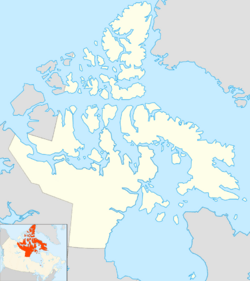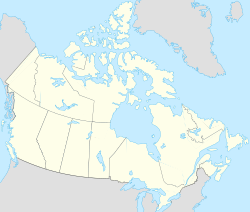North Midway Island facts for kids
| Geography | |
|---|---|
| Location | Chesterfield Inlet |
| Coordinates | 63°42′15″N 92°04′00″W / 63.70417°N 92.06667°W |
| Archipelago | Canadian Arctic Archipelago |
| Administration | |
| Territory | Nunavut |
| Region | Kivalliq |
| Demographics | |
| Population | Uninhabited |
North Midway Island is an island in Canada. It is located in the Canadian Arctic. This island is part of the Kivalliq Region in Nunavut.
The island has an unusual shape. You can find it inside Chesterfield Inlet. North Midway Island has a twin island. This twin is called South Midway Island. It is located about 1 km (0.62 mi) to the south.
Contents
Where is North Midway Island?
North Midway Island is in northern Canada. It is part of the Canadian Arctic Archipelago. This is a huge group of islands. They are located in the Arctic Ocean.
The island belongs to Nunavut. This is Canada's largest and newest territory. Nunavut is known for its vast, open spaces. It has a very cold climate.
Chesterfield Inlet's Role
North Midway Island sits within Chesterfield Inlet. An inlet is a narrow arm of the sea. It stretches inland. Chesterfield Inlet is a long waterway. It connects to Hudson Bay.
What is an Uninhabited Island?
North Midway Island is an uninhabited island. This means no people live there. Many islands in the Arctic are uninhabited. They are often too cold or remote.
Why are Islands Uninhabited?
Islands can be uninhabited for many reasons.
- Harsh weather: The Arctic has very cold winters. Summers are short and cool.
- Remote location: It is hard to reach these islands. They are far from towns.
- Lack of resources: There might not be enough fresh water. Food sources can be scarce.
Life on Uninhabited Islands
Even without people, these islands are important. They provide homes for wildlife. Animals like polar bears and seals live there. Birds also use them for nesting.
The Arctic Environment
The Arctic is a unique place. It has a special environment. This environment shapes life on North Midway Island.
Climate of the Arctic
The climate is very cold. Temperatures often drop below freezing. Snow and ice cover the land for most of the year. The ground is often permafrost. This means it is frozen all the time.
Wildlife in the Region
Animals living here are adapted to the cold.
- Polar bears: They hunt seals on the ice.
- Arctic foxes: They have thick fur for warmth.
- Seals: They live in the cold waters.
- Migratory birds: Many birds visit in summer. They come to nest and raise young.
Exploring Arctic Islands
Exploring these islands is challenging. It requires special gear. People who visit must be prepared for extreme cold. They also need to be aware of wildlife.
Research and Conservation
Scientists sometimes visit uninhabited islands. They study the environment. They also learn about wildlife. This helps protect these special places. Conservation efforts are important. They keep the Arctic healthy.



